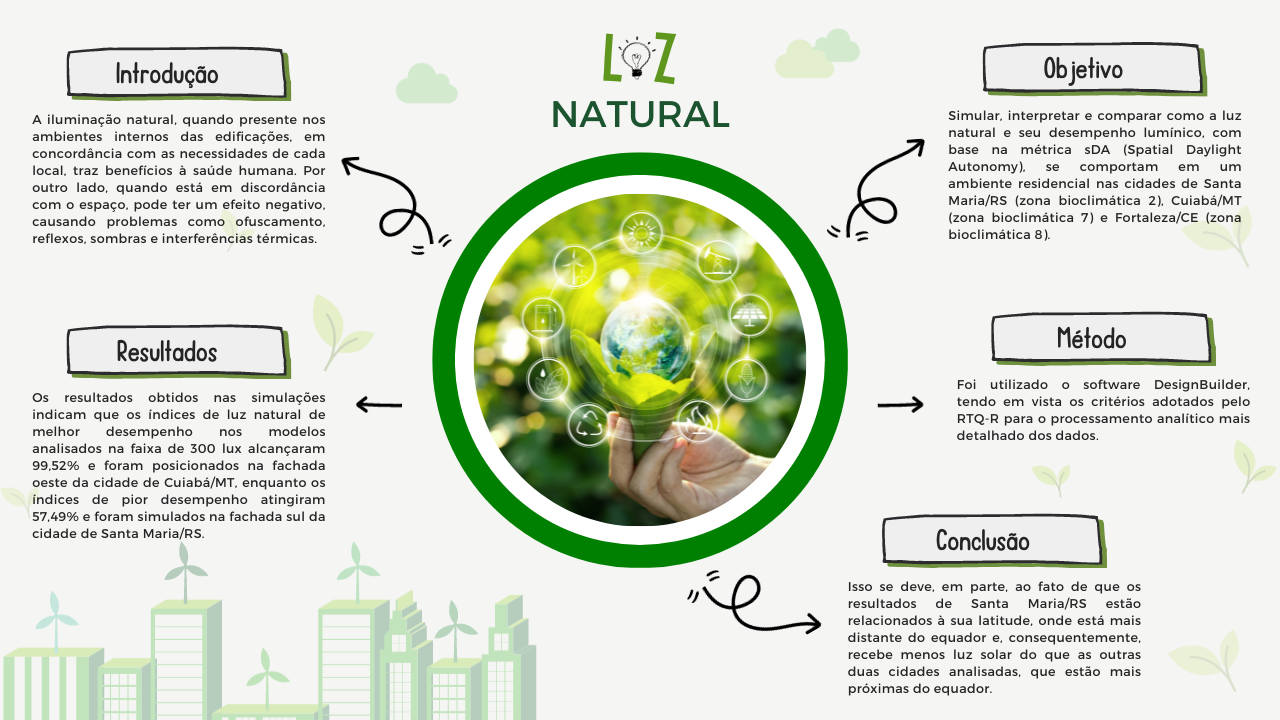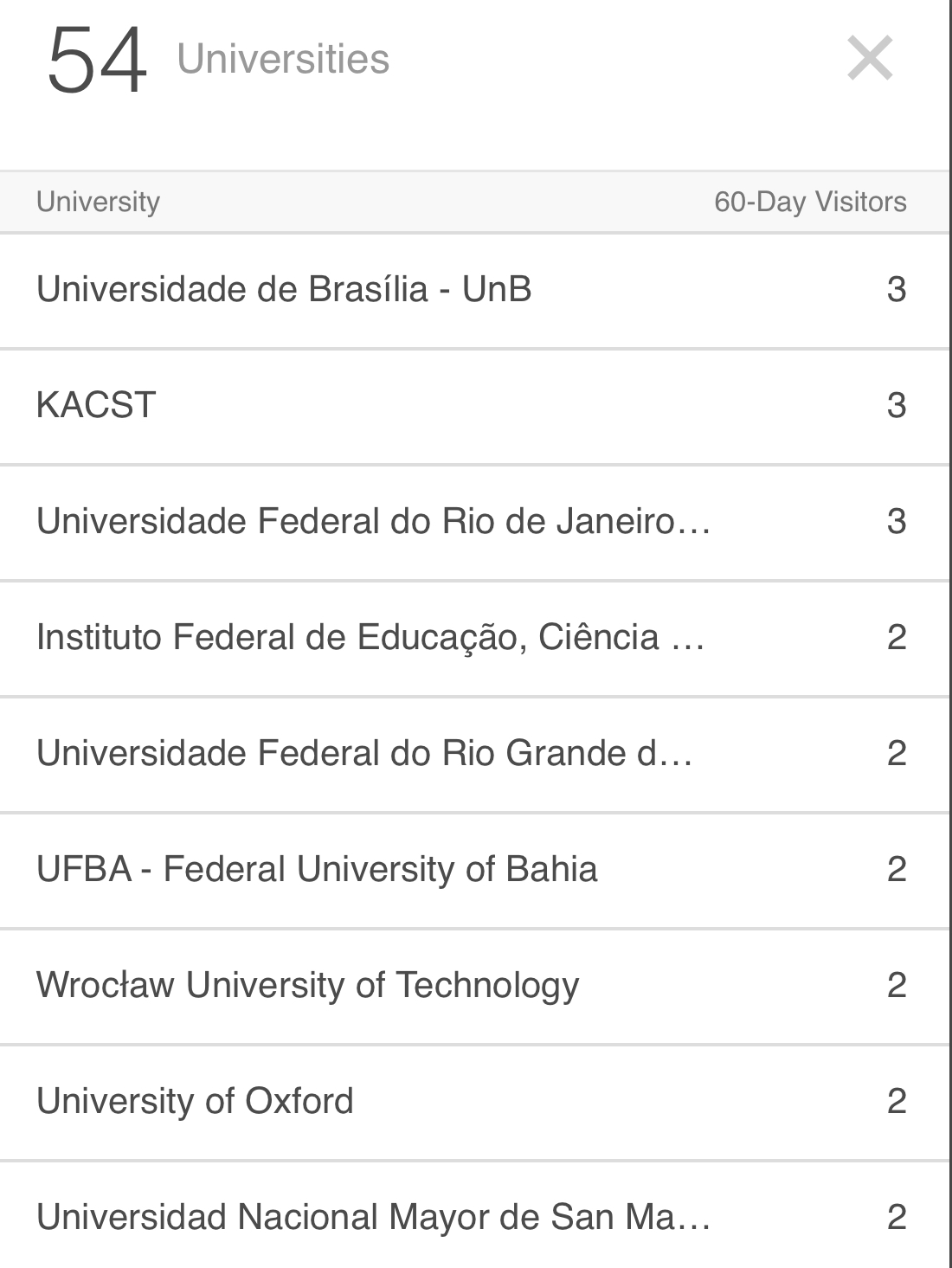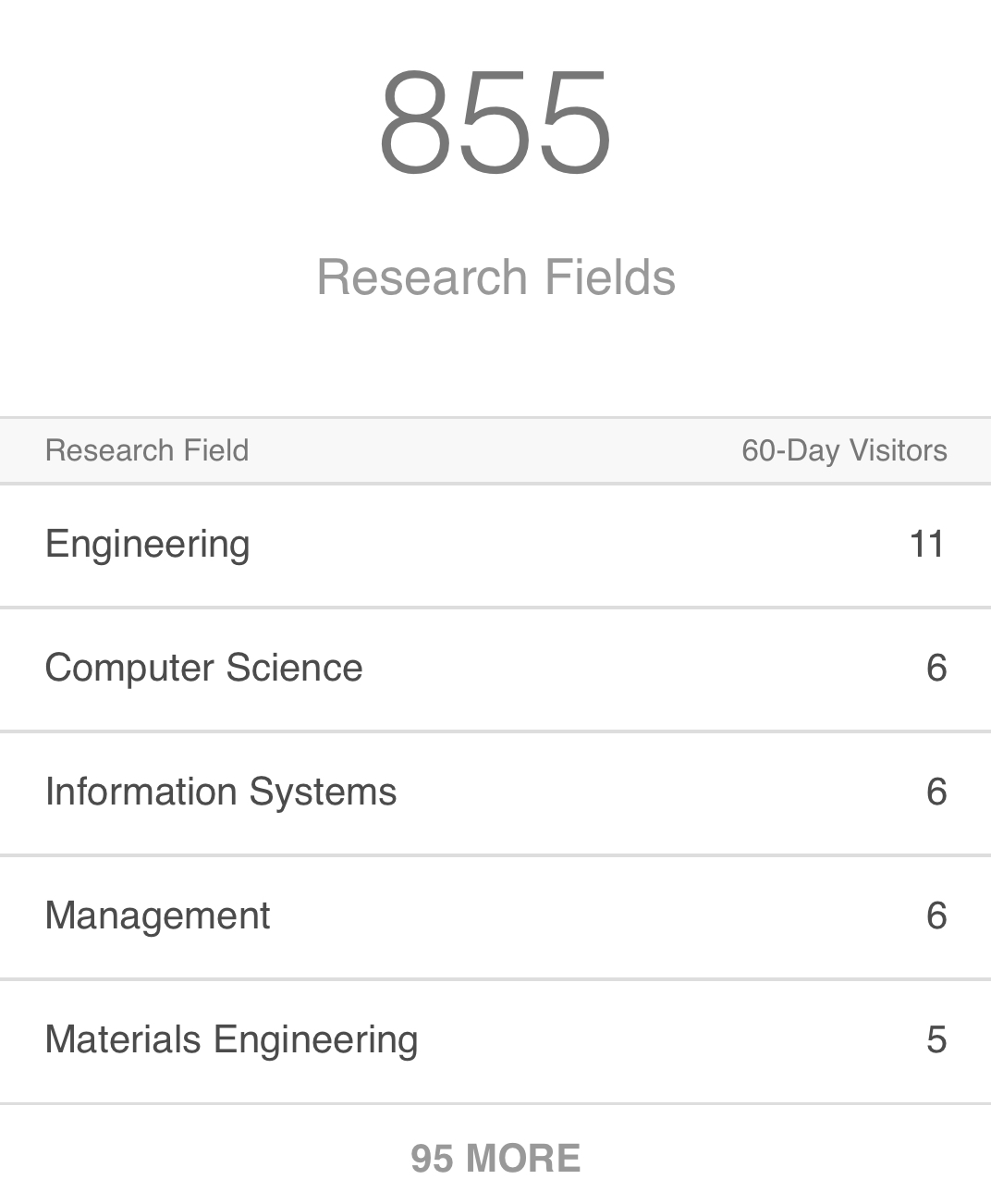Simulação computacional de luz natural em diferentes zonas bioclimáticas brasileiras
DOI:
https://doi.org/10.47456/bjpe.v10i1.42974Palavras-chave:
Eficiência energética, Métricas, SimulaçãoResumo
A iluminação natural, quando presente nos ambientes internos das edificações, em concordância com as necessidades de cada local, traz benefícios à saúde humana. Por outro lado, quando está em discordância com o espaço, pode ter um efeito negativo, causando problemas como ofuscamento, reflexos, sombras e interferências térmicas. Nesse sentido, esta pesquisa visa simular, interpretar e comparar como a luz natural e seu desempenho lumínico, com base na métrica sDA (Spatial Daylight Autonomy), se comportam em um ambiente residencial nas cidades de Santa Maria/RS (zona bioclimática 2), Cuiabá/MT (zona bioclimática 7) e Fortaleza/CE (zona bioclimática 8). Foi utilizado o software DesignBuilder, tendo em vista os critérios adotados pelo RTQ-R para o processamento analítico mais detalhado dos dados. Os resultados obtidos nas simulações indicam que os índices de luz natural de melhor desempenho nos modelos analisados na faixa de 300 lux alcançaram 99,52% e foram posicionados na fachada oeste da cidade de Cuiabá/MT, enquanto os índices de pior desempenho atingiram 57,49% e foram simulados na fachada sul da cidade de Santa Maria/RS. Isso se deve ao fato de que, no Hemisfério Sul, as fachadas norte e oeste recebem mais luz solar direta do que as fachadas sul e leste.
Downloads
Referências
Associação Brasileira de Normas Técnicas (2005). NBR 15220-3: Desempenho Térmico de Edificações, Parte 3: Zoneamento bioclimático brasileiro e diretrizes construtivas para habitações unifamiliares de interesse social, Rio de Janeiro.
Bajenaru, N., Damian, A., & Frunzulica, R. (2016). Evaluation of the energy performance for a nZEB office building under specific climatic conditions. Energy Procedia, 85(1), 26-34. https://doi.org/10.1016/j.egypro.2015.12.271
Benevides, M. (2020). Análise de conforto e desempenho térmico de habitações unifamiliares no semiárido mineiro (Monografia de Especialização da Escola de Arquitetura). Universidade Federal de Minas Gerais, Belo Horizonte, MG, Brasil. http://hdl.handle.net/1843/38589
Crawley, D. B. & Lawrie, L. K. (2023). Climate One Building. Repository of free climate data for building performance simulation. http://climate.onebuilding.org
Cuiabá. Lei complementar nº 102, de 03 de dezembro de 2003. Altera a Parte III da Lei Complementar Nº 004/92 Código de Obras e Edificações no Município de Cuiabá. Secretaria Municipal de Meio Ambiente e Desenvolvimento Urbano Sustentável, Cuiabá, 03 de dezembro de 2003.
Ekici, B., et al. (2021). Multi-zone optimisation of high-rise buildings using artificial intelligence for sustainable metropolises. Part 1: Background, methodology, setup, and machine learning results. Solar Energy, 224(1), 373-389. https://doi.org/10.1016/j.solener.2021.05.083
ELETROBRAS (2012). Manual para a aplicação do RTQ-R. Ministérios de Minas e Energia, 1(18), 201-202. https://www.pbeedifica.com.br
Faccin, C., et al. (2022). Análise estatística de séries de temperatura do ar da reanálise Merra-2: estudo de caso – Rio Grande do Sul. Anais do 36º Congresso de Pesquisa e Ensino em Transportes, Fortaleza, CE, Brasil, 1-12p. https://proceedings.science/anpet-2022/trabalhos/analise-estatistica-de-series-de-temperatura-do-ar-da-reanalise-merra-2-estudo-d?lang=pt-br
Fortaleza. Lei nº 5.530 de 17 de dezembro de 1981. Dispõe sobre o Código de Obras e Posturas do município de Fortaleza e dá outras providências. Procuradoria Geral do Município, Fortaleza, 17 de dezembro de 1981.
Košir, M., Iglič, N., & Kunič, R. (2018). Optimisation of heating, cooling and lighting energy performance of modular buildings in respect to location’s climatic specifics. Renewable energy, 129(1), 527-539. https://doi.org/10.1016/j.renene.2018.06.026
LabEEE/UFSC (2018). Laboratório de Eficiência Energética em Edificações da Universidade Federal de Santa Catarina. Arquivos Climáticos. Recuperado de https://labeee.ufsc.br/downloads/arquivos-climaticos
Lamberts, R., Dutra, L., & Pereira, F. O. R. (2014). Eficiência energética na arquitetura. 3ª Ed. São Paulo, SP: PW Editores. https://labeee.ufsc.br/pt-br/publicacoes/livros
Nascimento, J. W. S., do., et al. (2023). The role of occupational safety in road works: Implementation of preliminary risk analysis in the execution of asphalt resurfacing. Research, Society and Development, 12(11), e129121143778. https://doi.org/10.33448/rsd-v12i11.43778
Queiroz, F. M. et al. (2021). Causes and risks of pathological manifestations in the historic facades of Manaus. Cap. 10, 71-79pp. Belo Horizonte, MG: Editora Poisson. https://doi.org/10.36229/978-65-5866-082-8.CAP.10
Sampaio, A. T., Nascimento, J. W. S., & Sousa, D. S. V. (2020). Patologia de fachadas: revisão de literatura. Cap. 15, 178-187pp. Ponta Grossa, PR: Atena Editora. https://doi.org/10.22533/at.ed.87320210915
Sampaio, A. T., Souza N., J. W., & Santos, S. G. M. (2022). A aplicabilidade rentável das estacas pré-moldadas de concreto armado. Revista Eletrônica Acervo Científico, 40(1), 25-26. https://doi.org/10.25248/anais.e9587.2022
Santa Maria. Lei complementar nº 070, de 04 de novembro de 2009. Dispõe sobre o código de Obras e Edificações do Município de Santa Maria e dá outras providências. Secretaria de Município de Gestão e Modernização Administrativa, Santa Maria, 04 de novembro de 2009.
Santos, S. G. M., et al. (2022). Diagnóstico e recomendações para manifestações patológicas em uma edificação residencial unifamiliar. Anais do V Congresso Brasileiro de Patologia das Construções, Gramado, RS, Brasil, 583-594p. https://doi.org/10.4322/CBPAT.2022.051
Sentelhas, P. C., et al. (2014). Köppen’s climate classification map for Brazil. Meteorologische Zeitschrift, 22(6), 711-728. https://doi.org/10.1127/0941-2948/2013/0507
Sepúlveda, A. et al. (2020). Analyzing the fulfillment of daylight and overheating requirements in residential and office buildings in Estonia. Building and Environment, 180(1), 107036. https://doi.org/10.1016/j.buildenv.2020.107036
Souza N., J. W. (2019). O efeito da utilização de biomateriais na restauração de estruturas de concreto empregando bactérias como agentes de cura. Anais do 1º Congresso Online de Engenharia de Materiais, Rio de Janeiro, RJ, Brasil, 1p. https://eventos.congresse.me/eventos/engmatcon/anais
Souza N., J. W. & Sampaio, A. T. (2020). Characterization of concrete coating using bacteria as a floor regeneration agent. Anais do 62º Congresso Brasileiro do Concreto, Florianópolis, SC, Brasil, 1-15p. https://www.ibracon.org.br/eventos/62cbc/artigos/62cbc/artigos
Souza N., J. W., Santos, S. G. M., & Sampaio, A. T. (2021). Variação dos riscos ergonômicos no ambiente de trabalho em um canteiro de obras. Anais do 23º Congresso Nacional de Engenharia de Segurança do Trabalho, Londrina, PR, Brasil, 138-141p. https://www.anest.org.br
Zwirtes, G. L., et al. (2022a). Análise preliminar de risco e análise ergonômica do trabalho em laboratório de anatomia animal. Anais do XXVIII Congresso Nacional de Estudantes de Engenharia Mecânica, Santa Maria, RS, Brasil, 1-8p. https://eventos.abcm.org.br/anais
Zwirtes, G. L., et al. (2022b). Práticas de aprendizagem em ergonomia e segurança do trabalho – AET e APR em laboratório de anatomia animal. Anais da Semana Internacional das Engenharias e Economia da FAHOR, Horizontina, RS, Brasil, 1-13p. https://doi.org/10.29327/170181.2022-8

Downloads
Publicado
Edição
Seção
Licença
Copyright (c) 2024 Jéssica Wanderley Souza do Nascimento, Allefy Teles Sampaio, Sílvio Lisbôa Schuster, Sabiana Gilsane Mühlen dos Santos, Mariana Ferreira Umbelino, Hugo Leonardo Menezes de Sales (Autor)

Este trabalho está licenciado sob uma licença Creative Commons Attribution 4.0 International License.

Atribuição 4.0 internacional CC BY 4.0 Deed
Esta licença permite que outros remixem, adaptem e desenvolvam seu trabalho não comercialmente, contanto que eles creditem a você e licenciem suas novas criações sob os mesmos termos.



2.png)


























































